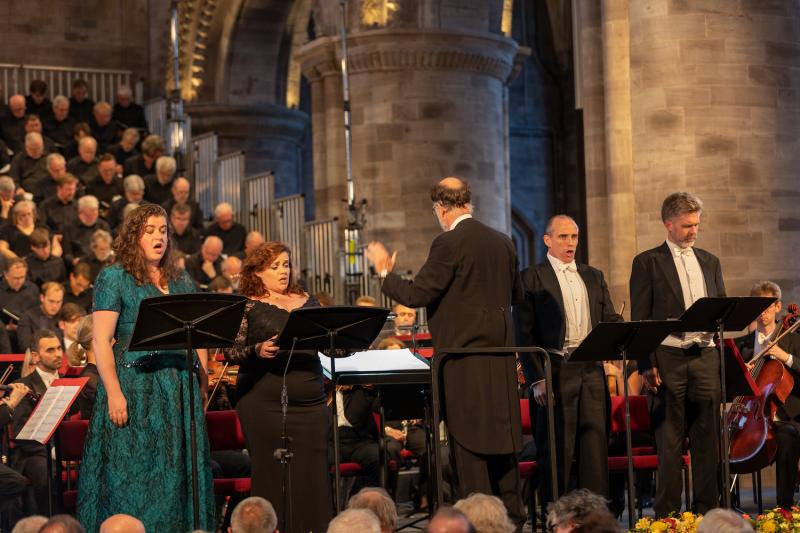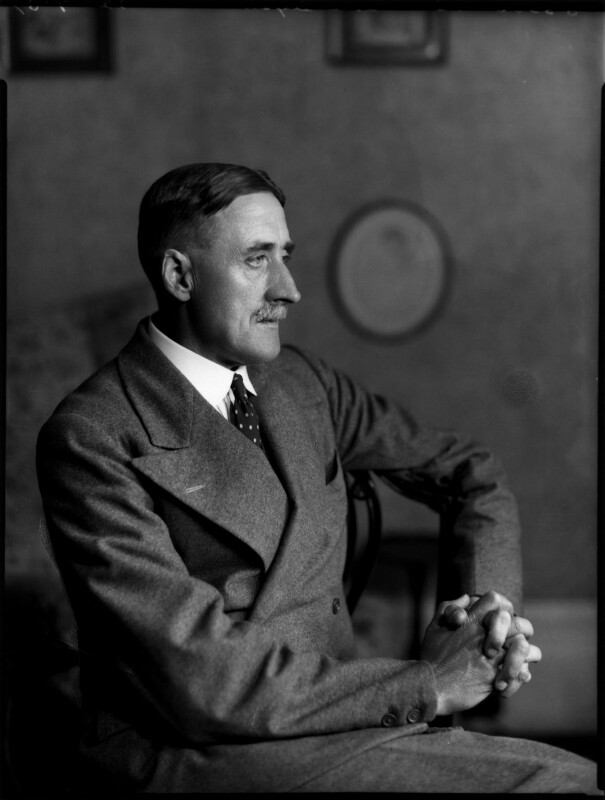Quo vadis, Three Choirs Festival review - a hundred minutes of smug serenity and flowing piety | reviews, news & interviews
Quo vadis, Three Choirs Festival review - a hundred minutes of smug serenity and flowing piety
Quo vadis, Three Choirs Festival review - a hundred minutes of smug serenity and flowing piety
Fine singing and playing but not enough muscle in the music

Once upon a time the Three Choirs Festival conjured up a single image, that of the English Oratorio – the grand choral solemnification of everything that was most profound in Anglican thought (though ironically its greatest exemplar, Elgar’s Dream of Gerontius, was irretrievably Catholic, and one Anglican bishop is supposed to have said he wouldn’t allow it into his cathedral).
Today the festival’s image is more diverse, but it still sometimes hankers after the good old days, with their smug serenities and flowing pieties, and this revival of George Dyson’s 100-minute long Quo vadis, first performed complete here in Hereford Cathedral in 1949, is its latest tribute to this by now somewhat raddled tradition.
To be exact, Quo vadis (Where are you going?) is not really an oratorio at all, but a hyper-inflated song cycle: solo and choral settings of poetry by various poets with a single overarching theme, mankind’s life as a spiritual pilgrimage from the cradle (of Wordsworth’s "Intimations of Immortality") to the “white radiance of eternity” in Shelley’s "Adonais".
To call this a big subject would be like calling Einstein a clever man. Britten, whose Serenade and Spring Symphony were between them roughly Quo Vadis’s contemporaries, contented himself with themes such as Night, Sleep and the Seasons, but endowed them with music of such character and brilliance that they seem to reach beyond their ostensible topics.
 Dyson, by ironic contrast, was palpably and embarrassingly restricted by his (George Dyson, pictured left © National Portrait Gallery, London). Though he was reportedly sympathetic to, or at least conversant with, modern developments in music in the Thirties, his own style adds little to things he might have found in Elgar or early Vaughan Williams, or at best Frank Bridge. His technique, well honed to deal with the minute-by-minute intricacies of late romantic texture, harmony and orchestration, is mostly helpless in face of the structural demands of a work on this scale. And the result is a score that maunders its way rather aimlessly, long-windedly, sometimes beautifully, through poetry of greatly varying character, seldom varying its own manner or tone, reacting now and then to moments of obvious drama but soon lapsing into its default mode of reflective, mildly elevated lyricism. It’s music that one could perhaps love in 10-minute slices. At ten times that length the sensibilities rebel.
Dyson, by ironic contrast, was palpably and embarrassingly restricted by his (George Dyson, pictured left © National Portrait Gallery, London). Though he was reportedly sympathetic to, or at least conversant with, modern developments in music in the Thirties, his own style adds little to things he might have found in Elgar or early Vaughan Williams, or at best Frank Bridge. His technique, well honed to deal with the minute-by-minute intricacies of late romantic texture, harmony and orchestration, is mostly helpless in face of the structural demands of a work on this scale. And the result is a score that maunders its way rather aimlessly, long-windedly, sometimes beautifully, through poetry of greatly varying character, seldom varying its own manner or tone, reacting now and then to moments of obvious drama but soon lapsing into its default mode of reflective, mildly elevated lyricism. It’s music that one could perhaps love in 10-minute slices. At ten times that length the sensibilities rebel.
I would think it a by no means easy work to put together, but on the whole the Festival Chorus and the Philharmonia Orchestra under the super-dependable Adrian Partington did it proud. There were the usual problems of cathedral acoustics and balance. From my seat well back in Hereford’s Norman nave the chorus sounded strong and committed, the four soloists too remote. But this was clearly an effect of space and distance. Musically they were a first-rate team: the soprano Rebecca Hardwick, particularly good in Henry Vaughan’s “Waterfall” (“Dear stream! dear bank!”, with some lovely woodwind scoring), Jess Dandy, a proper contralto such as one rarely hears today, the tenor James Oxley, saddled with Dyson’s lumbering setting of a heavily subedited Shelley but making it at least half-convincing, and the bass Alex Ashworth, excellent in the work’s too few muscular moments.
As for Dyson himself, he remains the composer of the colourful and lively Canterbury Tales (done in the past at the Three Choirs), and of the immortal Dyson in D major service, remembered with modified affection by all erstwhile church choristers. He was also, unexpectedly, the author of a First World War training pamphlet on the use of hand grenades. He could perhaps usefully have applied some of its lessons to Quo vadis.
rating
Explore topics
Share this article
Add comment
The future of Arts Journalism
You can stop theartsdesk.com closing!
We urgently need financing to survive. Our fundraising drive has thus far raised £49,000 but we need to reach £100,000 or we will be forced to close. Please contribute here: https://gofund.me/c3f6033d
And if you can forward this information to anyone who might assist, we’d be grateful.

Subscribe to theartsdesk.com
Thank you for continuing to read our work on theartsdesk.com. For unlimited access to every article in its entirety, including our archive of more than 15,000 pieces, we're asking for £5 per month or £40 per year. We feel it's a very good deal, and hope you do too.
To take a subscription now simply click here.
And if you're looking for that extra gift for a friend or family member, why not treat them to a theartsdesk.com gift subscription?
more Classical music
 BBC Proms: Liu, Philharmonia, Rouvali review - fine-tuned Tchaikovsky epic
Sounds perfectly finessed in a colourful cornucopia
BBC Proms: Liu, Philharmonia, Rouvali review - fine-tuned Tchaikovsky epic
Sounds perfectly finessed in a colourful cornucopia
 BBC Proms: Suor Angelica, LSO, Pappano review - earthly passion, heavenly grief
A Sister to remember blesses Puccini's convent tragedy
BBC Proms: Suor Angelica, LSO, Pappano review - earthly passion, heavenly grief
A Sister to remember blesses Puccini's convent tragedy
 BBC Proms: A Mass of Life, BBCSO, Elder review - a subtle guide to Delius's Nietzschean masterpiece
Mark Elder held back from blasting the audience with a wall of sound
BBC Proms: A Mass of Life, BBCSO, Elder review - a subtle guide to Delius's Nietzschean masterpiece
Mark Elder held back from blasting the audience with a wall of sound
 BBC Proms: Le Concert Spirituel, Niquet review - super-sized polyphonic rarities
Monumental works don't quite make for monumental sounds in the Royal Albert Hall
BBC Proms: Le Concert Spirituel, Niquet review - super-sized polyphonic rarities
Monumental works don't quite make for monumental sounds in the Royal Albert Hall
 Frang, Romaniw, Liverman, LSO, Pappano, Edinburgh International Festival 2025 review - sunlight, salt spray, Sea Symphony
Full force of the midday sea in the Usher Hall, thanks to the best captain at the helm
Frang, Romaniw, Liverman, LSO, Pappano, Edinburgh International Festival 2025 review - sunlight, salt spray, Sea Symphony
Full force of the midday sea in the Usher Hall, thanks to the best captain at the helm
 Elschenbroich, Grynyuk / Fibonacci Quartet, Edinburgh International Festival 2025 review - mahogany Brahms and explosive Janáček
String partnerships demonstrate brilliant listening as well as first rate playing
Elschenbroich, Grynyuk / Fibonacci Quartet, Edinburgh International Festival 2025 review - mahogany Brahms and explosive Janáček
String partnerships demonstrate brilliant listening as well as first rate playing
 BBC Proms: Akhmetshina, LPO, Gardner review - liquid luxuries
First-class service on an ocean-going programme
BBC Proms: Akhmetshina, LPO, Gardner review - liquid luxuries
First-class service on an ocean-going programme
 Budapest Festival Orchestra, Iván Fischer, Edinburgh International Festival 2025 review - mania and menuets
The Hungarians bring dance music to Edinburgh, but Fischer’s pastiche falls flat
Budapest Festival Orchestra, Iván Fischer, Edinburgh International Festival 2025 review - mania and menuets
The Hungarians bring dance music to Edinburgh, but Fischer’s pastiche falls flat
 Classical CDs: Hamlet, harps and haiku
Epic romantic symphonies, unaccompanied choral music and a bold string quartet's response to rising sea levels
Classical CDs: Hamlet, harps and haiku
Epic romantic symphonies, unaccompanied choral music and a bold string quartet's response to rising sea levels
 Kolesnikov, Tsoy / Liu, NCPA Orchestra, Chung, Edinburgh International Festival 2025 review - transfigured playing and heavenly desire
Three star pianists work wonders, and an orchestra dazzles, at least on the surface
Kolesnikov, Tsoy / Liu, NCPA Orchestra, Chung, Edinburgh International Festival 2025 review - transfigured playing and heavenly desire
Three star pianists work wonders, and an orchestra dazzles, at least on the surface
 BBC Proms: Láng, Cser, Budapest Festival Orchestra, Iván Fischer review - idiomatic inflections
Bartók’s heart of darkness follows Beethoven’s dancing light
BBC Proms: Láng, Cser, Budapest Festival Orchestra, Iván Fischer review - idiomatic inflections
Bartók’s heart of darkness follows Beethoven’s dancing light

Comments
This work, which had its